


Ruthenium chemistry
The element ruthenium is one of the so-called 'platinum group'. Ruthenium is a rare element, which is remarkably inert. It can be dissolved, however, using a strongly oxidizing and alkaline solution, prepared by dissolving sodium hydroxide in bleach. Once a solution is made with ruthenium, then it can be shown in many different oxidation states. The element ruthenium has a remarkably rich aqueous chemistry.
In this experiment, ruthenium is dissolved in an aqueous solution, and next it is brought in many different oxidation states, both in alkaline and in acidic environments.
![]()
![]() Required
chemicals:
Required
chemicals:
-
ruthenium, powdered
-
bleach (the cheapest stuff, without detergents and perfumes)
-
sodium hydroxide
-
dilute hydrochloric acid, approximately 10% HCl
-
dilute sulphuric acid, approximately 10% H2SO4
-
potassium persulfate
-
zinc
-
sodium sulfite
![]() Required
equipment:
Required
equipment:
-
test tubes
-
bunsen burner or equivalent for heating the contents of test tubes
![]() Safety:
Safety:
- Bleach is corrosive. Although it is very common in the household, its risks should not be underestimated. Especially when it is hot, one has to be careful.
- Dilute hydrochloric acid is corrosive.
- Sodium hydroxide is very caustic. If some of this comes on the skin, then rinse with water until the greasy feeling has disappeared.
- At a certain stage of this experiment, a small amount of chlorine gas is formed. This is a toxic gas, which however, can easily be recognized by its smell. The amount of gas, formed in this experiment is small, but it is suggested to do the experiment outside, or at least in a well-ventilated room.
-
 In the final stage
of this experiment, ruthenium is brought to its +8 oxidation state in the
form of ruthenium tetroxide. This compound is very hazardous, because of the
potential damage it can bring to the eyes. At the same time, chlorine gas is
formed, which may mask the smell of ruthenium tetroxide. If the final part
of the experiment is performed, then please do this outside or in a fume
hood (kitchen exhaust is not sufficient). Even milligram quantities of
ruthenium tetroxide are said to be very dangerous.
In the final stage
of this experiment, ruthenium is brought to its +8 oxidation state in the
form of ruthenium tetroxide. This compound is very hazardous, because of the
potential damage it can bring to the eyes. At the same time, chlorine gas is
formed, which may mask the smell of ruthenium tetroxide. If the final part
of the experiment is performed, then please do this outside or in a fume
hood (kitchen exhaust is not sufficient). Even milligram quantities of
ruthenium tetroxide are said to be very dangerous.
![]() Disposal:
Disposal:
- The amount of metal waste, generated in this experiment is so small, that it can be flushed down the drain with a lot of water.
![]()
Dissolving ruthenium metal
Although ruthenium metal is very inert, it can be dissolved in alkaline bleach. In order to dissolve the metal, the following steps must be performed:
![]() Take some bleach with approximately 5% active chlorine.
Take some bleach with approximately 5% active chlorine.
![]() Dissolve some sodium hydroxide in the bleach.
Dissolve some sodium hydroxide in the bleach.
![]() Put between 25 and 50 mg of ruthenium metal in a
dry test tube and pour the alkaline bleach on the metal. When this is done, one
can see that the metal dissolves very slowly, forming a brown liquid.
Put between 25 and 50 mg of ruthenium metal in a
dry test tube and pour the alkaline bleach on the metal. When this is done, one
can see that the metal dissolves very slowly, forming a brown liquid.
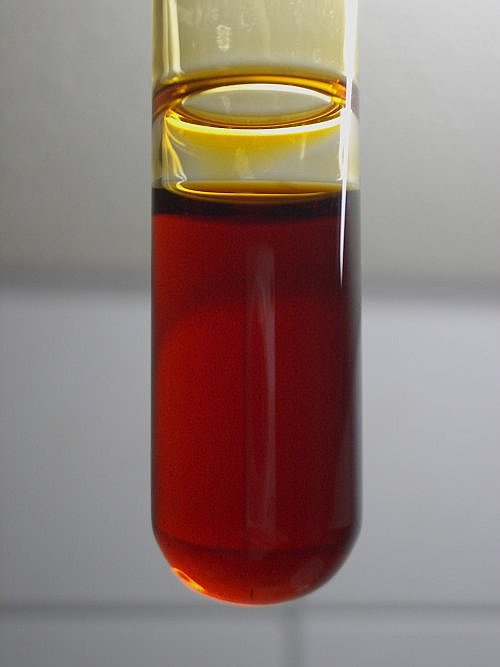
![]() Heat the liquid, in order to dissolve the metal at an
acceptable rate. During the heating, the metal dissolves. A lot of gas is
evolved in this experiment. This is oxygen from decomposing hypochlorite. The
metal dissolves and the liquid becomes brown. This brown color is due to
formation of a mix of ruthenium compounds in oxidation states +6 and +7.
Heat the liquid, in order to dissolve the metal at an
acceptable rate. During the heating, the metal dissolves. A lot of gas is
evolved in this experiment. This is oxygen from decomposing hypochlorite. The
metal dissolves and the liquid becomes brown. This brown color is due to
formation of a mix of ruthenium compounds in oxidation states +6 and +7.
![]() Let liquid stand for 1 day in a loosely stoppered test tube.
During this day, the liquid becomes bright red/orange with a color of high
intensity. The ruthenium becomes dissolved in its +6 oxidation state as the
ruthenate ion, which can be described as RuO42-. The
picture shows the test tube with the deep red liquid. This contains between 0.5%
and 1% ruthenium metal by weight as ruthenate ion.
Let liquid stand for 1 day in a loosely stoppered test tube.
During this day, the liquid becomes bright red/orange with a color of high
intensity. The ruthenium becomes dissolved in its +6 oxidation state as the
ruthenate ion, which can be described as RuO42-. The
picture shows the test tube with the deep red liquid. This contains between 0.5%
and 1% ruthenium metal by weight as ruthenate ion.
![]() Next, two experiments are done, each with approximately 25%
of the liquid shown above. So, the total amount of ruthenium metal used here is
very small and is in the order of magnitude of 10mg per experiment.
Next, two experiments are done, each with approximately 25%
of the liquid shown above. So, the total amount of ruthenium metal used here is
very small and is in the order of magnitude of 10mg per experiment.
![]()
Oxidation states of ruthenium at high pH
In this experiment, ruthenium is shown in the +6, +7 and +4 oxidation states. It first is oxidized from +6 to +7 and then it is reduced to its +4 oxidation state.
![]() Take approximately 25% of the deep red liquid, as prepared
according to the procedure above and dilute this with some water. This diluted
liquid is a nice red/orange liquid. It is shown in the left picture below. This
contains ruthenium in its +6 oxidation state as RuO42-.
Take approximately 25% of the deep red liquid, as prepared
according to the procedure above and dilute this with some water. This diluted
liquid is a nice red/orange liquid. It is shown in the left picture below. This
contains ruthenium in its +6 oxidation state as RuO42-.
![]() To this diluted liquid add an excess amount of potassium
persulfate and heat this liquid for a while. The red liquid turns brown with a
slight greenish tinge. This liquid is shown in the middle picture below. While
the color changes, a lot of gas is produced as well. This is due to
decomposition of the persulfate, in which oxygen gas is produced. The brown
color is due to the presence of ruthenium in its +7 oxidation state as RuO4.
This ion is not very stable in strong alkalies. It fairly quickly changes back to the red RuO42-.
To this diluted liquid add an excess amount of potassium
persulfate and heat this liquid for a while. The red liquid turns brown with a
slight greenish tinge. This liquid is shown in the middle picture below. While
the color changes, a lot of gas is produced as well. This is due to
decomposition of the persulfate, in which oxygen gas is produced. The brown
color is due to the presence of ruthenium in its +7 oxidation state as RuO4.
This ion is not very stable in strong alkalies. It fairly quickly changes back to the red RuO42-.
![]() Finally, add an excess amount of sodium sulfite. This first
reduces the brown/green compound to the red compound again, but reduction goes
further, until a dark blue/black precipitate is formed. This blue/black
precipitate redissolves again to the red compound, because of the presence of
persulfate in the liquid, which acts as a slow oxidizer. However, at a certain
point, when no persulfate is left anymore, the precipitate does not redissolve
anymore. The dark precipitate is shown in the right picture below. The dark
blue/black precipitate is ruthenium dioxide, with ruthenium in its +4 oxidation
state. The formula of this compound is RuO2.
Finally, add an excess amount of sodium sulfite. This first
reduces the brown/green compound to the red compound again, but reduction goes
further, until a dark blue/black precipitate is formed. This blue/black
precipitate redissolves again to the red compound, because of the presence of
persulfate in the liquid, which acts as a slow oxidizer. However, at a certain
point, when no persulfate is left anymore, the precipitate does not redissolve
anymore. The dark precipitate is shown in the right picture below. The dark
blue/black precipitate is ruthenium dioxide, with ruthenium in its +4 oxidation
state. The formula of this compound is RuO2.
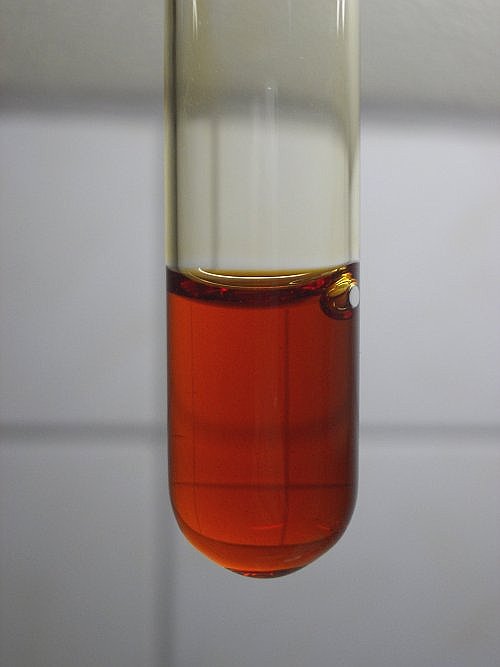
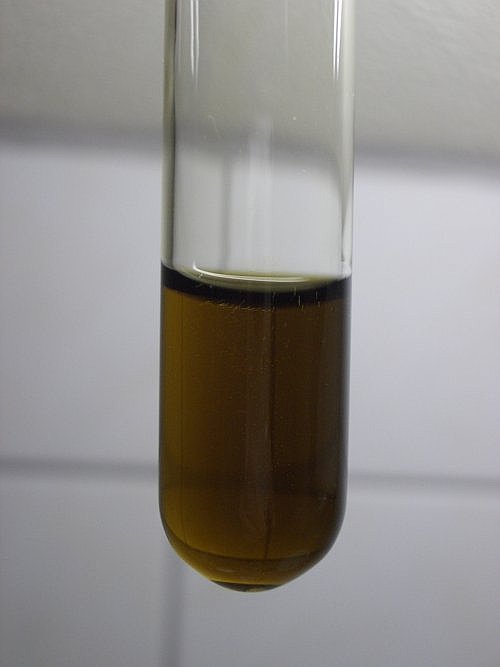
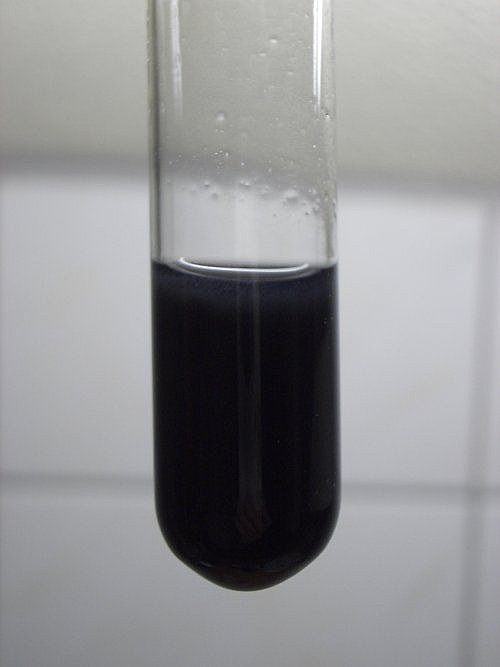
![]()
Oxidation states of ruthenium at low pH
In this experiment, ruthenium is shown in oxidation states +4, +3, +2 and back from +2, +3, +4 up to +8. First it is reduced with zinc metal, all the way down to +2. Then it is oxidized again to +3 by water. Further oxidation from +3 all the way up to +8 is accomplished with potassium persulfate.
Disproportionation of Ru(+6) to Ru(+7) and Ru(+4) on acidification
![]() Take approximately 25% of the initial deep red solution, made
with bleach. Add a small amount of sulphuric acid to this. This results in
formation of a green/brown liquid and some precipitation of black particles. The
red ruthenate ion disproportionates to green/brown perruthenate and ruthenium
(IV) oxide.
Take approximately 25% of the initial deep red solution, made
with bleach. Add a small amount of sulphuric acid to this. This results in
formation of a green/brown liquid and some precipitation of black particles. The
red ruthenate ion disproportionates to green/brown perruthenate and ruthenium
(IV) oxide.
Here, two pictures are shown of adding some acid to the deep-red solution. Some black ruthenium (IV) oxide is formed and green/brown ruthenium (VII) is formed. The right picture shows the green liquid, which is decanted from the left test tube after waiting some time, with the solid particles left behind. So, the perruthenate ion RuO4 is dirty green.
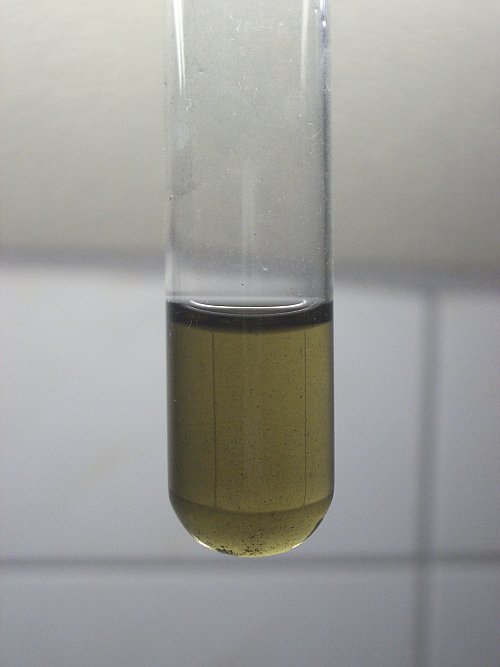
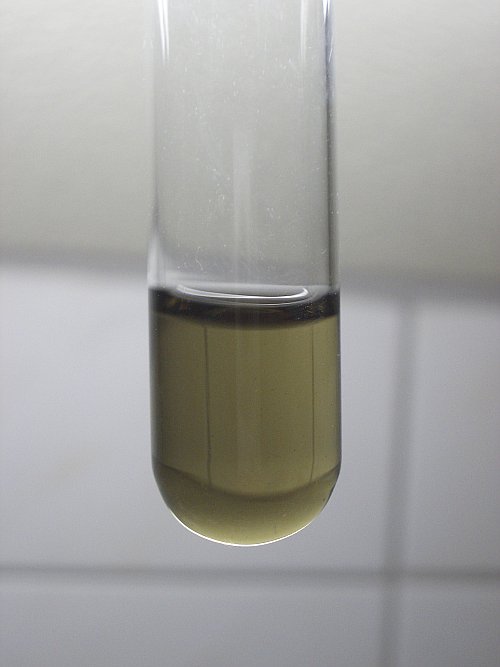
![]() Next, take another part of approximately 25% of the initial
deep red solution, made with bleach, and add a large excess amount of
hydrochloric acid to this. This results in formation of a brown liquid.
This color can be explained by the disproportionation of the ruthenate ion. Now
in the strongly acidic environment with large excess amounts of chloride
present, the ruthenium (IV) does not form the oxide, but a soluble red ruthenium
(IV) species, RuCl62-. The mix of the dirty green
perruthenate and the reddish RuCl62- gives rise to the
observed brown color.
Next, take another part of approximately 25% of the initial
deep red solution, made with bleach, and add a large excess amount of
hydrochloric acid to this. This results in formation of a brown liquid.
This color can be explained by the disproportionation of the ruthenate ion. Now
in the strongly acidic environment with large excess amounts of chloride
present, the ruthenium (IV) does not form the oxide, but a soluble red ruthenium
(IV) species, RuCl62-. The mix of the dirty green
perruthenate and the reddish RuCl62- gives rise to the
observed brown color.
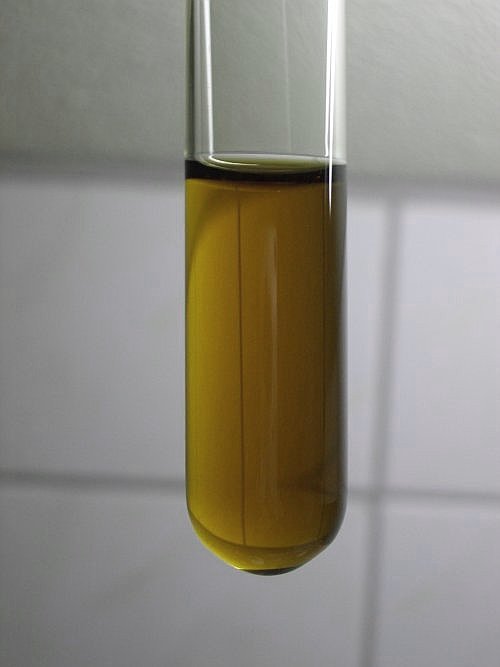
Reduction to Ru(+2), going through oxidation states +4 and +3
For this part of the experiment the red/brown liquid with the large excess amount of hydrochloric acid is taken as starting point.
![]() Add a spatula full of coarsely powdered zinc to the red/brown liquid and loosely
stopper the test tube. The zinc dissolves, while producing a fairly large amount
of hydrogen gas. The color of the liquid first becomes bright red/brown, when
the ruthenium in its +7 oxidation state is reduced to the +4 oxidation state. This is
shown in the picture at the left below.
Add a spatula full of coarsely powdered zinc to the red/brown liquid and loosely
stopper the test tube. The zinc dissolves, while producing a fairly large amount
of hydrogen gas. The color of the liquid first becomes bright red/brown, when
the ruthenium in its +7 oxidation state is reduced to the +4 oxidation state. This is
shown in the picture at the left below.
![]() After a
while, when almost all of the intensely colored red/brown ruthenium in the +4 oxidation state
is reduced, the liquid quickly turns yellow/orange. This is a much lighter
color than the red/brown color of ruthenium in its +4 oxidation state. This is
the +3 oxidation state of ruthenium. This oxidation state is shown in the second
picture from the left.
(The liquid shown here probably still contains a very small amount of ruthenium
(IV). Pure ruthenium (III) is somewhat less orange, as is shown further below,
when the ruthenium is oxidized again from +2 to +3 oxidation state.)
After a
while, when almost all of the intensely colored red/brown ruthenium in the +4 oxidation state
is reduced, the liquid quickly turns yellow/orange. This is a much lighter
color than the red/brown color of ruthenium in its +4 oxidation state. This is
the +3 oxidation state of ruthenium. This oxidation state is shown in the second
picture from the left.
(The liquid shown here probably still contains a very small amount of ruthenium
(IV). Pure ruthenium (III) is somewhat less orange, as is shown further below,
when the ruthenium is oxidized again from +2 to +3 oxidation state.)
![]() When the
reduction further continues, the liquid becomes grey for a short time. This is a
mix of ruthenium in its +3 oxidation state and ruthenium in its +2 oxidation
state. The orange/yellow color of ruthenium (III) and blue color of ruthenium
(II) mix up to a color with absorption over the full visible spectrum. This
makes the liquid appear grey. Finally, the liquid becomes blue, with a slight
purplish tinge. This is ruthenium in its +2 oxidation state.
When the
reduction further continues, the liquid becomes grey for a short time. This is a
mix of ruthenium in its +3 oxidation state and ruthenium in its +2 oxidation
state. The orange/yellow color of ruthenium (III) and blue color of ruthenium
(II) mix up to a color with absorption over the full visible spectrum. This
makes the liquid appear grey. Finally, the liquid becomes blue, with a slight
purplish tinge. This is ruthenium in its +2 oxidation state.
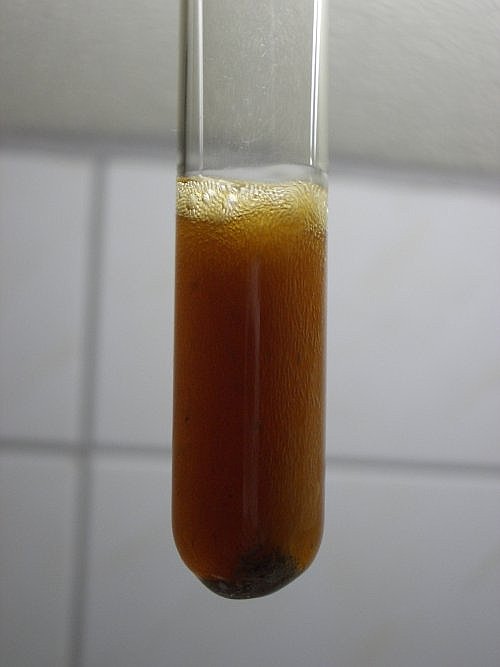
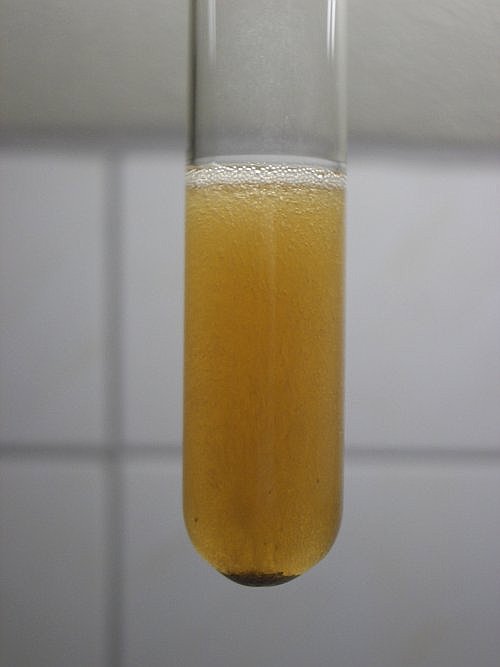
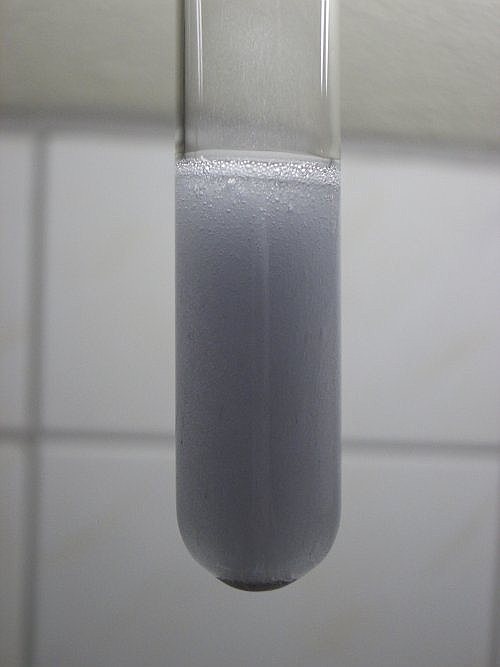
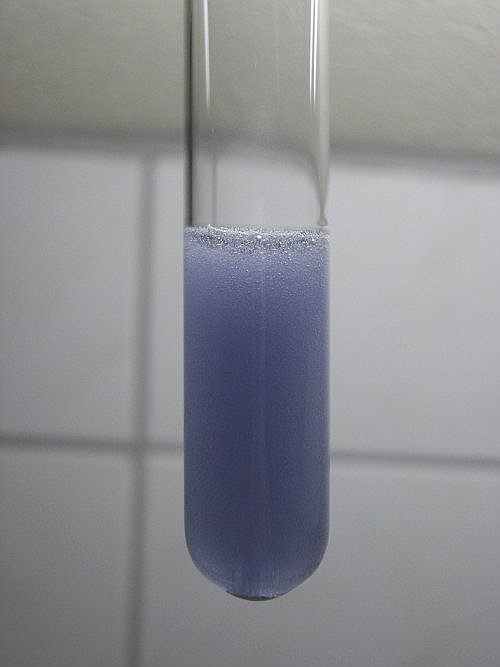
All pictures, shown above, show "turbidity". This is not real turbidity, but this is due to small bubbles of hydrogen, produced by dissolving the zinc metal in the acid. At the bottom, the zinc metal can be seen as a dark solid.
The large picture below shows the test tube, when just a tiny amount of zinc metal is left. It shows the hydrogen bubbles, produced at the zinc, and the nice color of the ruthenium in its +2 oxidation state. This picture shows that the liquid is clear and that there is no real turbidity.
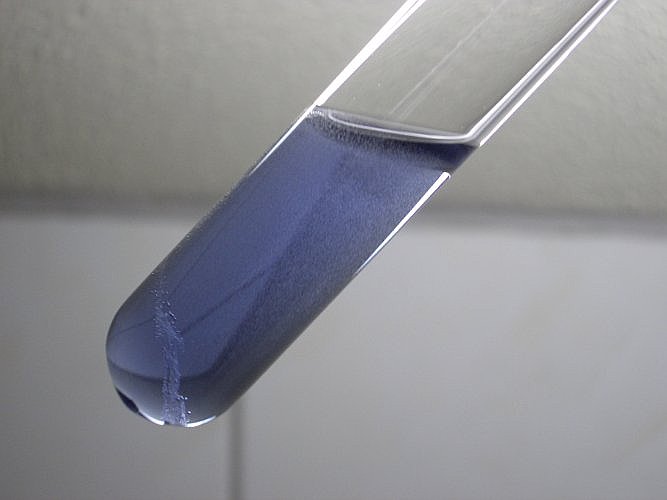
The blue ruthenium (II) is very unstable. As soon as all zinc is dissolved, the oxidation back to ruthenium (III) starts again. Within half an hour, the liquid has turned light orange/yellow/brown again. The complete liquid has changed color in just such a short time, not only the liquid near the surface. Probably, the water is reduced by the blue ruthenium (II). If oxygen from the air were the oxidizing agent, then there would be an orange/yellow layer near the surface and not the whole liquid would have changed color in such a short time.
With more concentrated ruthenium solutions, it is hard to get a blue liquid. With zinc, the liquid becomes grey/blue (mix of Ru2+ and Ru3+), but as soon as the zinc is used up it becomes grey again very quickly, indicating that an appreciable amount of the Ru2+ is oxidized again.
Oxidation to Ru(+8) through oxidation states +3 and +4
![]() Taking the orange/yellow/brown liquid with Ru3+ as starting point, the
ruthenium is oxidized all the way up, to its +8 oxidation state. This is done by
adding quite some potassium persulfate and heating of the liquid. While the
liquid is heated, a sequence of colors is traversed. The liquid starts as a
light yellow/orange/brown liquid with ruthenium in its +3 oxidation state. It
becomes bright and much more intense red/brown with ruthenium in its +4
oxidation state. Finally it becomes bright yellow, when ruthenium is oxidized to
its +8 oxidation state. Apparently, no oxidation state +7 is obtained in
strongly acidic
media with lots of excess persulfate in the liquid. When the liquid goes from red to yellow, it just becomes lighter,
it does not change color to green or brown as intermediate stage.
Taking the orange/yellow/brown liquid with Ru3+ as starting point, the
ruthenium is oxidized all the way up, to its +8 oxidation state. This is done by
adding quite some potassium persulfate and heating of the liquid. While the
liquid is heated, a sequence of colors is traversed. The liquid starts as a
light yellow/orange/brown liquid with ruthenium in its +3 oxidation state. It
becomes bright and much more intense red/brown with ruthenium in its +4
oxidation state. Finally it becomes bright yellow, when ruthenium is oxidized to
its +8 oxidation state. Apparently, no oxidation state +7 is obtained in
strongly acidic
media with lots of excess persulfate in the liquid. When the liquid goes from red to yellow, it just becomes lighter,
it does not change color to green or brown as intermediate stage.
![]() When the liquid has
become red, then one might want to stop the experiment by stoppering the test
tube and disposing of the liquid, by immersing the test tube under water and
then unstoppering it. On continuation of the experiment, the very hazardous RuO4
is produced, which easily volatilizes and comes into the air. In the experiment
conducted here, the test tube was stoppered with a porous cork (allowing gas to
escape). After the experiment, the cork was dark and when it was immersed in
water, an orange solution was obtained. This shows that quite some RuO4
volatilized and escaped from the liquid.
When the liquid has
become red, then one might want to stop the experiment by stoppering the test
tube and disposing of the liquid, by immersing the test tube under water and
then unstoppering it. On continuation of the experiment, the very hazardous RuO4
is produced, which easily volatilizes and comes into the air. In the experiment
conducted here, the test tube was stoppered with a porous cork (allowing gas to
escape). After the experiment, the cork was dark and when it was immersed in
water, an orange solution was obtained. This shows that quite some RuO4
volatilized and escaped from the liquid.
The four pictures, shown below show the oxidation of the ruthenium. The left picture shows the ruthenium in its +3 oxidation state, before adding the potassium persulfate. The next picture shows the ruthenium in its red/brown +4 oxidation state. The third picture shows the oxidation all the way up to the +8 oxidation state. The bubbles in the liquid are a mixture of chlorine gas, made by oxidation of HCl by hot persulfate, oxygen, and volatile RuO4.
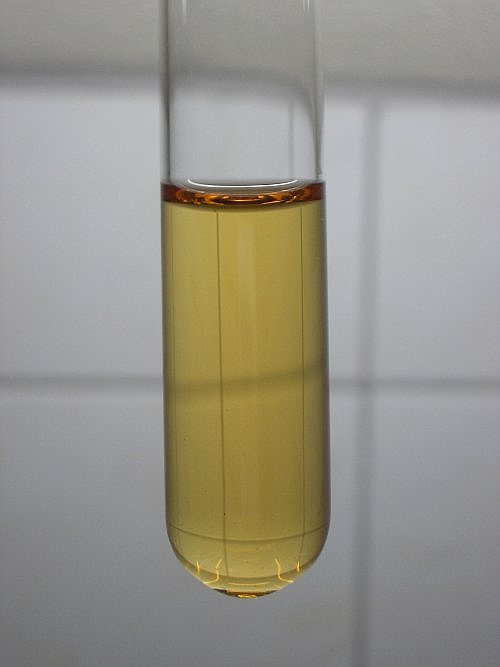
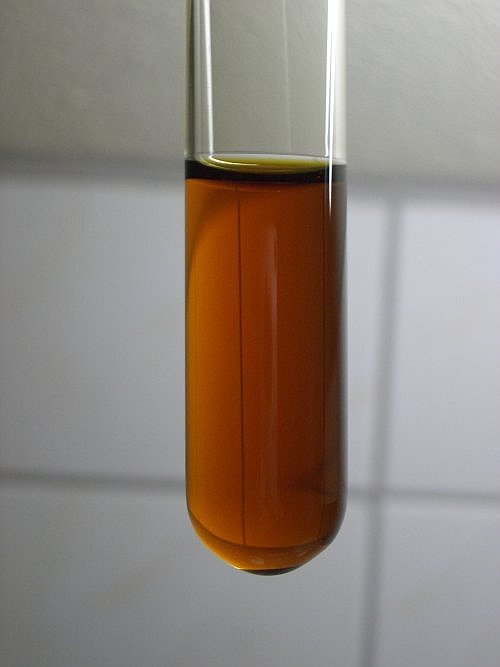
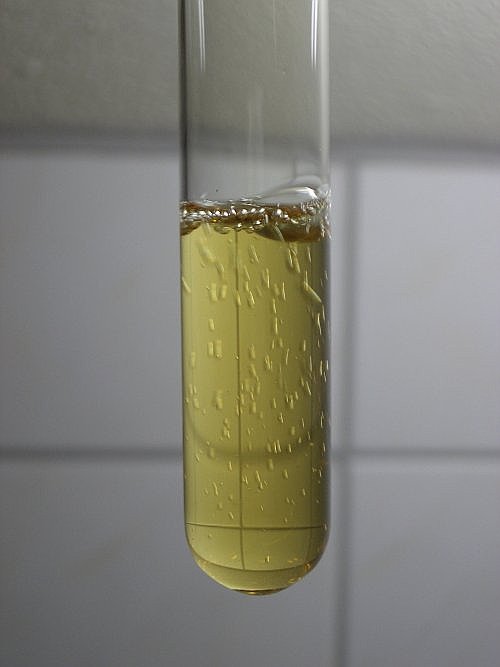
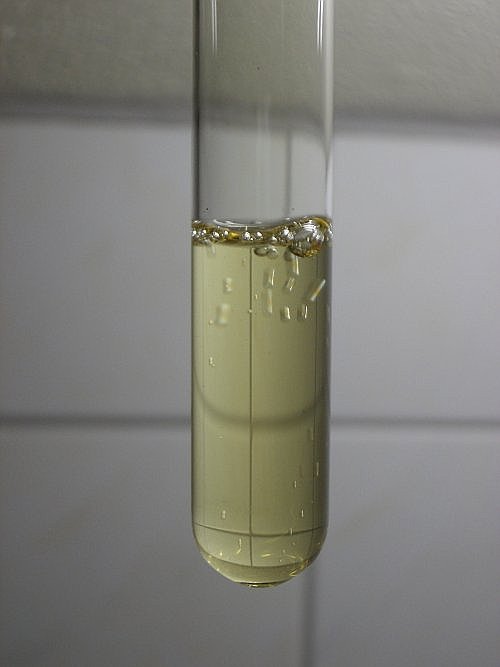
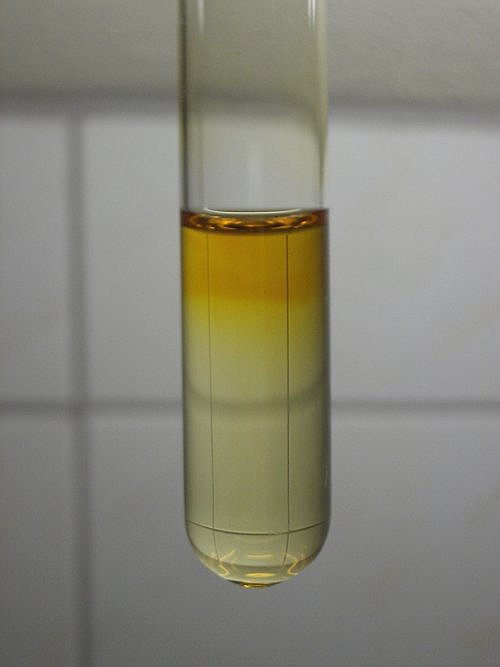 When
heating is continued for a longer time, then most of the RuO4
volatilizes and a small part of the RuO4 oxidizes
the hydrochloric acid. Finally, most of the ruthenium has left the liquid as
volatile RuO4 and a light yellow liquid remains, containing some
ruthenium in its +3 oxidation state. This light yellow liquid is shown in the
picture at the left. When the test tube with the light yellow liquid is allowed to
stand for a day, then the glass of the test tube becomes covered by a thin layer
of red/brown ruthenium (IV) and the liquid also becomes red again. Probably,
oxygen from the air or remains of chlorine and RuO4 in the air above
the liquid oxidize the ruthenium (III) to ruthenium (IV). This explains the
orange color near the surface of the liquid, while the lower part still is light
yellow. This is shown in the small picture at the right.
When
heating is continued for a longer time, then most of the RuO4
volatilizes and a small part of the RuO4 oxidizes
the hydrochloric acid. Finally, most of the ruthenium has left the liquid as
volatile RuO4 and a light yellow liquid remains, containing some
ruthenium in its +3 oxidation state. This light yellow liquid is shown in the
picture at the left. When the test tube with the light yellow liquid is allowed to
stand for a day, then the glass of the test tube becomes covered by a thin layer
of red/brown ruthenium (IV) and the liquid also becomes red again. Probably,
oxygen from the air or remains of chlorine and RuO4 in the air above
the liquid oxidize the ruthenium (III) to ruthenium (IV). This explains the
orange color near the surface of the liquid, while the lower part still is light
yellow. This is shown in the small picture at the right.
![]()
Discussion of results
When ruthenium is dissolved in an alkaline liquid, containing bleach, then it is oxidized to red ruthenate and to brown/green perruthenate:
Ru + 3ClO + 2OH → RuO42 + 3Cl + H2O
2Ru + 7ClO + 2OH → 2RuO4 + 7Cl + H2O
The resulting liquid becomes dull brownish/red.
The perruthenate decomposes slowly at the alkaline conditions, by oxidizing hydroxide ions:
4RuO4 + 4OH → 4RuO42 + O2 + 2H2O
Finally, the liquid becomes bright and intense red, due to the presence of the ruthenate ions. Ruthenate has a deep red color. At low concentrations it is bright orange/red.
At high pH, the ruthenate can be oxidized to perruthenate again, as shown by the first series of pictures. It can also be reduced to hydrous ruthenium dioxide, RuO2·nH2O. This is an insoluble dark blue/black solid.
The deep red ruthenate ion RuO42- is not stable at low pH. In HCl it disproportionates to green/brown RuO4 and brown/red RuCl62-. This makes the liquid appear brown initially. When zinc is added, then the ruthenium is reduced to the +4 oxidation state and then the liquid looks nice bright brown/red, showing the color of the complex ion RuCl62-.
In acidic media, ruthenium can be further reduced all the way down to blue ions, best described as Ru2+(aq). This is a very strong reductor. It even reduces water and can only be kept for minutes. The most stable oxidation state of ruthenium in acidic media is the yellow/brown/orange Ru3+(aq). This ion can also be obtained with mild reducing agents. E.g., when sodium sulfite is added to a solution, containing the deep red ruthenate ion, then the liquid becomes much lighter yellow/orange/brown. This is due to reduction of ruthenate (VI) to ruthenium (III).
Zinc is capable of reducing ruthenium (III) even further to ruthenium (II).